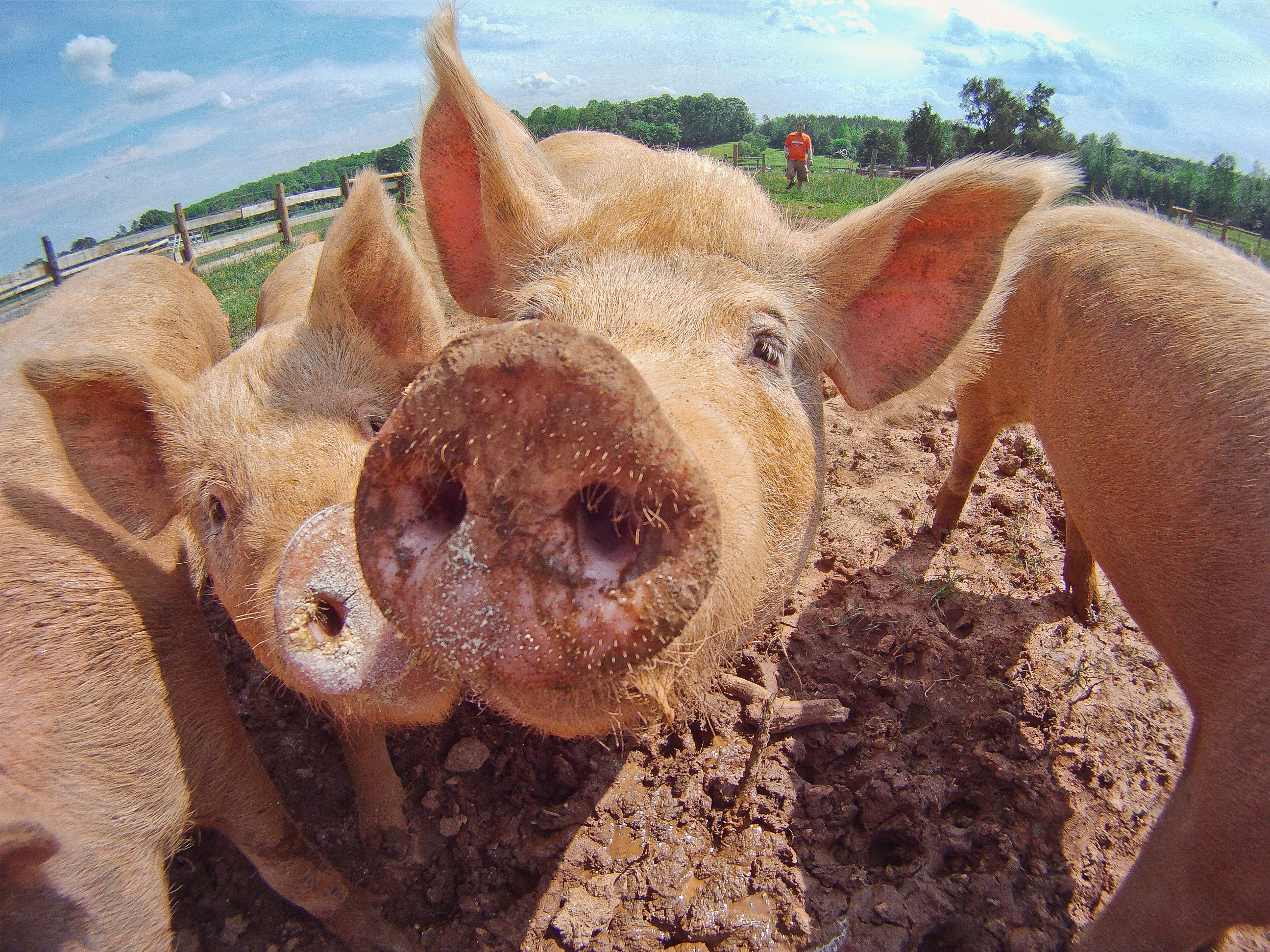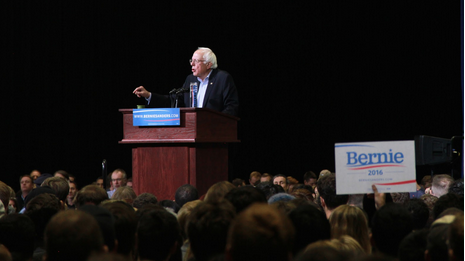While the prevailing perception of pigs among most urban white-collar workers may revolve around a cute, fun-loving ball of fur, the same animal represents pollution, environmental harm, and food injustice for many rural communities of color. In North Carolina, for example, the hog population has more than doubled in recent decades—from 2.8 million in 1990 to 9.3 million in 2000.[1] Besides the strong stench emitted from these farms, the air and water pollution caused by hog farming has proven links to health problems, such as nausea and asthma, and reduces the availability of clean drinking water.[2] A failure to adequately enforce food and environmental laws, combined with historical land injustices and limited access to healthy, affordable food, contributes heavily to environmental racism, a force that disproportionately stifles the health and economic opportunity of racial communities.
While laws preventing excessive and irresponsible use of fossil fuels exist, they are often inadequately enforced by government agencies. Under the Trump administration, employment in the Environmental Protection Agency (EPA) was reduced from about 15,000 workers at the end of the Obama administration to 14,162 workers, with a 15.7% cut in employment in the Office of Enforcement and Compliance Assurance.[3][4] This reduction in staff limits the ability of the government to regulate the use of fossil fuels such as coal, which is commonly used to process dairy and to seal metal cans in food production facilities.[5]
The use of coal is also pervasive in the agricultural sector, accounting for 15% of the energy used to produce potatoes.[6] This unsustainable fuel source has devastating environmental impacts on local communities. One effect of burning coal in production facilities are coal ash ponds, which are landfills of the carcinogenic burnt coal that accumulate near coal-burning factories.[7] In December 2017, a coal ash pond in North Carolina leaked into the water supply and compromised the ability of residents to access clean drinking water.[8] This environmental consequence arose from lax enforcement of existing EPA rules under the Trump administration that require ash ponds to be inspected.[9] At the local level, a lack of clean drinking water is often caused by meager enforcement of regulations that protect water sources from polluters.[10] Reduced access to clean water unduly affects poor communities, as these groups are significantly more likely to experience the sanitation deficiency and illnesses associated with insufficient access to water.[11]
Besides coal, the use of other fossil fuels in agriculture disproportionately harms communities of color and has lasting environmental impacts. Over 80% of both poultry and beef production uses coal, oil, or natural gas: all unsustainable, polluting fossil fuels.[12] Beyond the long-term unsustainability of fossil fuels due to rising prices and limited resources, using non-renewable energy to power food production also releases harmful gases, such as carbon monoxide and sulfur dioxide into the atmosphere.[13] On average, minority communities are located closer to food production facilities and factory farms.[14] As such, they are most affected by the release of harmful chemicals, which are associated with a multitude of health consequences including respiratory infections.[15]
The energy required to produce toxic fertilizers and pesticides also has environmental consequences. The production of nitrogen fertilizers, which requires natural gas and coal, accounts for over 50% of total energy use in commercial production.[16]
While the burning of fossil fuels is a damaging input into food production, manure is a dangerous output of the livestock industry. Unlike the highly regulated industry of human waste removal, untreated animal waste is commonly stored in structurally unsound manure lagoons. These large pits of feces are often only lined with clay, the contents frequently seeping into the local water supply and emitting greenhouse gases into the air.[17] While both local and national government regulations uphold standards for animal waste disposal, pressure from the livestock industry, as well as the disorganization and leniency exhibited by governmental institutions, allows companies to repeatedly violate health codes.[18]
In addition to instigating environmental and health concerns, a failure to adequately enforce environmental regulations and a loosening of environmental policies under the Trump administration have contributed to environmental racism. With regard to food production, recent policies permit the use of harmful pesticides, such as dicamba, that are known to impede brain development.[19] In fact, about 313,000 illnesses each year in America are related to pesticide use, exposure, and consumption.[20] The impact of harmful chemicals used in food production disproportionately affect people of color, as they account for over half of all farm workers.[21] Additionally, these groups are more likely to be situated near a production facility that uses these harmful pesticides and distribution centers that sell pesticide-ridden produce. For example, Hispanic children are 41% more likely to attend schools classified as a pesticide concern, in which chemicals used for local farming contaminate the air surrounding the school.[22] The proximity of communities of color to farms that use toxic chemicals place disproportionate health burdens on these groups.
The effects of environmental racism stemming from the food industry span from health violations in the agriculture stage to unequal distribution in the marketing and sharing of produce. Many low-income neighborhoods exist in a “food desert,” where the high price and inadequate availability of fresh food diminishes the ability of poorer residents, especially those of color, to access affordable and healthy foods. In 2014, one-quarter of Black and one-fifth of Latinx households in America were considered “food insecure,” a measure of local food accessibility and price. By the same measure, only one in ten White households were found to be food insecure.[23] The concentration of wholesome food stores in wealthy areas fuels the pervasive inequality in our society, a society in which over half of Latinx and Black children are obese.[24] In fact, research suggests that children living in areas with healthy food options have a 56% lower obesity rate than children in areas with reduced access to healthy and affordable food.[25] Improving health outcomes through access to healthy foods for minority communities helps break cycles of poverty and reduces the strain on medical facilities in already struggling areas.[26]
Historical injustices also contribute to systemic injustice in the food system. Policies that permitted banks to deny loans to minority farmers or charge higher interest rates contributed to a 20% loss of land for Black farmers between 1982 and 2012, compared to a 7.3% loss for all other farmers.[27] This land loss perpetuates the impoverishment of Black farm workers. Minimum wage laws established after the Great Depression also contribute to the disadvantagement of black farmers. Minimum wage laws did not apply to farm workers, the majority of which were minorities. Farmers and domestic workers, which included 75% of the Black population at that time, were also barred from receiving government benefits, such as Social Security.[28] These historically racist policies overtly prevented Blacks from achieving equality, and their effects continue today, as only 3.4% of agricultural land today is owned by Black and Latinx Americans combined.[29]
The effects of harmful food and land laws have immense impacts on local communities. In June 2018, the North Carolina legislature passed a Farm Act that severely restricts the ability of residents to file nuisance lawsuits against farm and livestock operations, which have been used to hold farm and factory owners accountable for disrupting the peace of residents. Under the new regulation, a lawsuit must be filed within a year of a farm opening, making it difficult for residents to seek redress for pollution through governmental channels.[30] Restrictions on avenues for restitution disproportionately affect people of color, who are over one-and-a-half times more likely than White residents to live within three miles of a pig farm in North Carolina.[31] One study found that schools in North Carolina with large populations of students of color are located on average over two times closer to hog farms than schools with fewer students of color.[32] Students in poorer schools also have a higher rate of asthma compared to students in wealthier schools located further from pig farms.[33] While rural North Carolina is a clear case study for how a lack of legal recourse for environmental harm affects poor people of color, it is only one small case study of how historical injustices and a poor enforcement of environmental laws systemically and disproportionately place the negative environmental externalities of food production on the rural poor.
The environmental harm posed to minority communities though the industrialization of agriculture hasn’t gone unnoticed among politicians. The national “Green New Deal” unveiled by the Democrats in early February is an attempt to reduce the harmful effects of fossil fuels, including a strategy for cutting emissions in the agricultural sector.[34] The current political stalemate, however, makes it extremely difficult to pass meaningful legislation that would protect minority communities from the exploitation of food manufacturers and corporate farms.
In addition to experiencing the harmful health effects associated with lack of access to nutritious food and environmentally irresponsible food production, minorities overall have fewer resources to protest food injustice. Poverty, which disproportionately affects people of color, reduces the ability of individuals to attend peaceful protests, write letters to politicians, and attend local government town hall events due to time and money constraints, as well as inequalities in educational opportunity. This reduced ability to protest discriminatory policies and business practices makes people of color highly susceptible to the environmental consequences stemming from unjust food and farming practices.
While the systematic disenfranchisement and impoverishment of certain communities of color reduces their ability to speak out against the environmental consequences of food production and distribution laws, people from all backgrounds and levels of privilege must demand responsible policies in order to curb environmental racism in the food industry. Laws that allow the use of toxic pesticides such as chlorpyrifos or those that allow factory farms to delay their reporting of hazardous substances released into the environment are only snippets of a larger body of policies that protect the interests of businesses over consumers.[35] A call for pesticide-free food would contribute to better health for both producers and consumers.[36] A demand for laws that promote and protect small farms and production centers, combined with a shift away from fossil fuels, could help curb the health and environmental impacts of pollution on local communities. And finally, mass recognition that many food production practices and environmental laws negatively affect communities of color will help force the government to reconcile the rights of communities to have a healthy environment with the desire for economic productivity.
[1] Hellerstein, Erika, and Ken Fine. “A Million Tons of Feces and an Unbearable Stench: Life near Industrial Pig Farms.” The Guardian. September 20, 2017. Accessed March 08, 2019. http://www.theguardian.com/us-news/2017/sep/20/north-carolina-hog-industry-pig-farms.
[2] Ibid
[3] Cama, Timothy. “EPA Staffing Falls to Reagan-era Levels.” The Hill. January 09, 2018. Accessed April 02, 2019. https://thehill.com/policy/energy-environment/368090-epa-staffing-hits-reagan-levels.
[4] Dennis, Brady, Juliet Eilperin, and Andrew Ba Tran. “With a Shrinking EPA, Trump Delivers on His Promise to Cut Government.” The Washington Post. September 08, 2018. Accessed March 25, 2019. https://www.washingtonpost.com/national/health-science/with-a-shrinking-epa-trump-delivers-on-his-promise-to-cut-government/2018/09/08/6b058f9e-b143-11e8-a20b-5f4f84429666_story.html?utm_term=.ce8c3ce173fa.
[5] “Coal Supports NZ Food Production.” Straterra. Accessed March 09, 2019. http://www.straterra.co.nz/mining-in-nz/importance-of-mining/everyone-uses-minerals/coal-supports-nz-food-production/.
[6] Ibid.
[7] Mele, Christopher. “What Is Coal Ash and Why Is It Dangerous?” The New York Times. November 01, 2018. Accessed March 09, 2019. http://www.nytimes.com/2018/09/21/us/coal-ash-spill-dam-breach.html.
[8] Ibid.
[9] Ibid.
[10] Jenkins, Matthew. “The impact of corruption on access to safe water and sanitation for people living in poverty” Transparency International. July 04, 2017. Accessed April 22, 2019.
[11] Wash. “Water and Poverty: How Access to Safe Water Reduces Poverty.” Lifewater International. December 26, 2014. Accessed April 22, 2019. https://lifewater.org/blog/water-poverty/.
[12] Woods, Jeremy et al. “Energy and the food system” Philosophical transactions of the Royal Society of London. Series B, Biological sciences vol. 365,1554 (2010): 2991-3006. Accessed March 11, 2019. https://www.ncbi.nlm.nih.gov/pmc/articles/PMC2935130/
[13] Pisupati, Sarma. “Products of Combustion.” Faults | Earth 520: Plate Tectonics and People: Foundations of Solid Earth Science. Accessed March 12, 2019. https://www.e-education.psu.edu/egee102/node/1951.
[14] “Environmental Racism.” Peeling Back the Truth on Bananas | Food Empowerment Project. Accessed March 09, 2019. http://www.foodispower.org/environmental-racism/.
[15] Ibid.
[16] Woods, Jeremy et al. “Energy and the food system”
[17] “What Happens to Animal Waste?” Food Print. Accessed March 12, 2019. https://foodprint.org/issues/what-happens-to-animal-waste/?cid=906.
[18] Ibid.
[19] Kimbrell, George. “6 Ways Trump Is Bad for Food, Health and the Environment.” EcoWatch. January 31, 2019. Accessed March 09, 2019. http://www.ecowatch.com/trump-gutted-regulations-2531641443.html.
[20] Fisher, Michael. “ENVIRONMENTAL RACISM CLAIMS BROUGHT UNDER TITLE VI OF THE CIVIL RIGHTS ACT.” Environmental Law, vol. 25, no. 2, 1995, pp. 285–334. JSTOR, www.jstor.org/stable/43266421.
[21] Rotner, Emma. “Food Equity: How Structural Racism Reduces Sustainability in the Food System.” Sustainability Institute. April 23, 2018. Accessed March 09, 2019. https://sustainableunh.unh.edu/blog/2016/07/food-equity-how-structural-racism-reduces-sustaianbility-food-system.
[22] Colins, Natalie et al. “Agricultural Pesticide Use Near Public Schools in California.” California Environmental Health Tracking Program. April, 2014. Accessed April 09, 2019. http://cehtp.org/file/pesticides_schools_report_april2014_pdf
[23] Hellerstein, Erika, and Ken Fine. “A Million Tons of Feces and an Unbearable Stench: Life near Industrial Pig Farms.”
[24] Hinkle-Brown, Don, Yael Lehmann, and Judith Bell. “Access to Healthy Food Improves Health, Brings Economic Benefits.” The Huffington Post. April 22, 2014. Accessed March 09, 2019. https://www.huffingtonpost.com/don-hinklebrown/access-to-healthy-food_b_4822735.html.
[25] Hilmers, Angela et al. “Neighborhood disparities in access to healthy foods and their effects on environmental justice” American Journal of Public Health vol. 102,9 (2012): 1644-54. Accessed March 114, 2019 https://www.centerforsocialinclusion.org/wp-content/uploads/2014/07/Building-the-Case-for-Racial-Equity-in-the-Food-System.pdf
[26] “Breaking the Cycle of Poverty.” San Diego Food Bank. 2016. Accessed April 25, 2019. https://sandiegofoodbank.org/wp-content/uploads/2017/10/SDFB17021-2016AnnualReport-digital_-_FINAL.pdf.
[27] Hilmers, Angela et al. “Neighborhood disparities in access to healthy foods and their effects on environmental justice”
[28] Gilbert, Jess, Spencer Ward, and Gwen Sharp. “Who Owns the Land?” Rural America 17, no. 4 (January/February 2002): 55-62. Accessed March 24, 2019. www.farmlandinfo.org.
[29] Woods, Jeremy et al. “Energy and the food system.”
[30] Blythe, Anne. “Hog Farmers Win New Protections as Lawmakers Override Roy Cooper’s Veto.” Newsobserver. June 27, 2018. Accessed March 25, 2019. https://www.newsobserver.com/news/politics-government/article213914154.html.
[31] Mock, Brentin. “North Carolina’s Environmental History Is Littered With Racial Injustice.” Pacific Standard. October 05, 2018. Accessed March 08, 2019. https://psmag.com/social-justice/environmental-racism-in-north-carolina.
[32] “Environmental Racism.” Peeling Back the Truth on Bananas | Food Empowerment Project. Accessed March 09, 2019. http://www.foodispower.org/environmental-racism/.
[33] Hellerstein, Erika, and Ken Fine. “A Million Tons of Feces and an Unbearable Stench: Life near Industrial Pig Farms.”
[34] Volcovici, Valerie. “U.S. Democrats Float ‘Green New Deal’ to End Fossil Fuel Era.” Japan Today. February 07, 1970. Accessed March 09, 2019. https://japantoday.com/category/world/update-2-u.s.-democrats-float-‘green-new-deal’-to-end-fossil-fuel-era.
[35] Kimbrell, George. “6 Ways Trump Is Bad for Food, Health and the Environment.”
[36] Lei, Yvonne Len and Apollon, Dominique. “The Color of Food.” Applied Research Center. February, 2011. Accessed March 11, 2019. https://www.raceforward.org/sites/default/files/downloads/food_justice_021611_F.pdf



